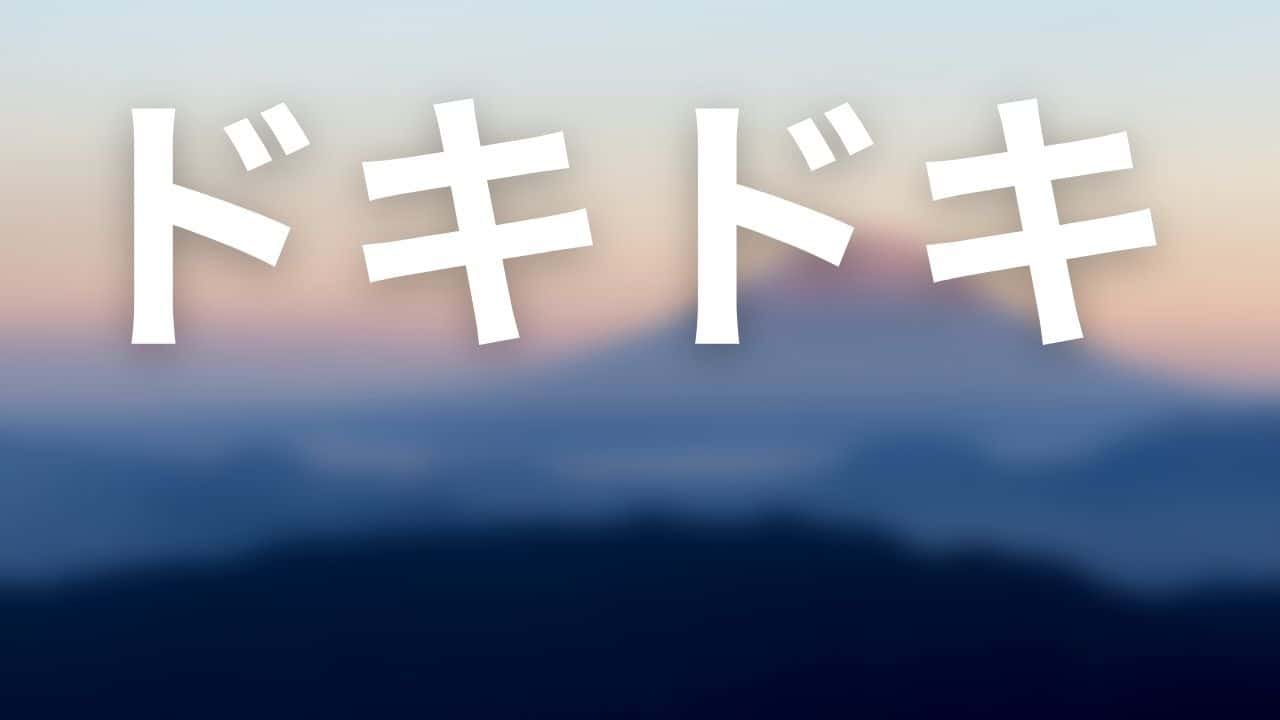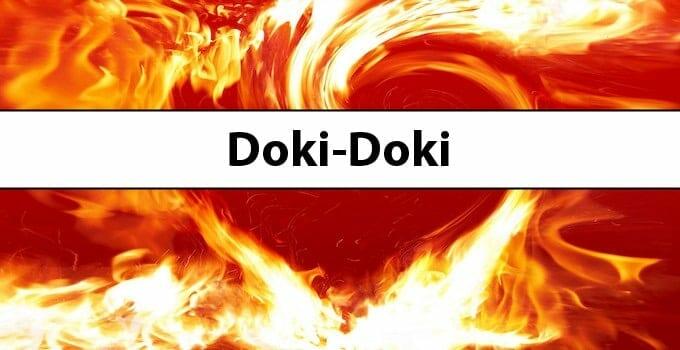The Japanese language is extraordinarily rich in onomatopoeia. Jaan! Goro-goro! Kobo-kobo! Tatatata!
A seemingly endless playground of often gleeful, sometimes confounding syllables strapped together to describe the essence of the world around us.
In this article, we’ll be discussing a worldwide phenomenon: doki-doki.
Before we get on to doki-doki’s meaning, a bit of a recap of what exactly onomatopoeia is, and how it differs between English and Japanese.
In English, onomatopoeia usually refers to words that mimic the sound of the thing they’re referencing.
The bee was buzzing.
The rain went pitter-patter.
Don’t bang the door!
Japanese, on the other hand, mixes things up a bit. They have at least five different categories for onomatopoeia, each with their own way of expressing something.
Gisei-go (擬声語) are words that represent sounds made by living things, like “meow,” “chirp,” and “gasp.”
Gion-go (擬音語) are for inanimate things, like the wind going “whoosh,” a hoop going “swish,” or a chip going “crunch.”
Then we get the unique categories, typically uncommon in Western languages, including English. These fall outside strict onomatopoeia and into the broader realm of ideophones.
Ideophones are any sort of word that is used to evoke a concept.
So, “buzz” and “whoosh” fit in, but so would a word inspired by wandering aimlessly (uro-uro), being solemn (shinmiri), or feeling cool (hinyari).
Gitai-go (擬態語) are words that describe the silent world around us. The Japanese language has a whole host of interesting words in this category.
There’s kira-kira for glittering, twinkling, and sparkling things. There’s sansan for brilliant sunlight.
And there’s the delightfully versatile fuwa-fuwa, which should inspire in your mind everything that comes along with being fluffy like a cloud—buoyant, soft, poofy, and even light-hearted.
Giyou-go (擬容語) describe someone’s behavior in an onomatopoeic way.
We get gaku-gaku for trembling knees, gun-gun for steadily, and uto-uto for nodding off.
I can’t figure out where they got these one’s from, but it’s sure interesting to think about!
Gijou-go (擬情語) is the last category we’ll cover here. Gijou-go are used to describe how someone feels.
You could describe someone’s worries as moya-moya. Or anxiously looking forward to something as waku-waku. Or perhaps hopefulness as uki-uki.
Doki-doki, however, is special. Doki-doki crosses the boundaries and exists as both gisei-go (sound of a living thing) and gijou-go (an emotional state).
The Meaning of Doki-Doki
So what exactly is the meaning of doki-doki? Listen for it! Can you hear it? It’s right there inside you—in your chest. Do…ki…do…ki when you’re relaxed. Dokidokidokidokidokidoki when you’re excited. In English, it goes by a couple of onomatopoetic expressions. Ba-dump! Lub-dub! Pitter-patter! In Japanese it’s doki-doki.
Let’s get into the meat and potatoes of what doki-doki means. According to the Sanseido dictionary:
心臓の鼓動が高くなるようす。
Shinzou-no-kodou ga takaku-naru yousu.
Okay, that probably didn’t mean a whole lot for most of you. Basically, what that breaks down to is: “The condition where the heartbeat grows faster.”
While this can just be a normal heart rate increase following a sprint or a jog up the stairs, often it’s tied to an emotion such as excitement, anticipation, fear, etc.
How’d Doki-Doki’s Meaning Get That Way?
How’d the Japanese end up with doki-doki for a heartbeat? Perhaps it sounds a little strange to you.
“Maybe my heart makes do sounds, but definitely not any ki sounds!”
Well, if you ask me, I think it fits pretty well on its own. But let’s take a look at the history anyway.
Going back into the Edo era—that age of stately samurai and shogun—we find examples of doki-doki already.
But we also find one other interesting word: douki (動悸), which means heart palpitation or throbbing.
Now, there’s a chance that doki-doki came from douki, but no concrete evidence.
In fact, about a century after the Edo era, we find some evidence that things are not quite that simple.
Come the Showa era—the period that stretched from before World War II and into the Eighties—writers were regularly using douki-douki as a play on doki-doki.
It’s suggested that these meanings got mixed up by readers and a pseudo-etymology was born.
Perhaps the truth is that they were originally two totally different words that got tossed together after the fact and made to seem like historically-connected phrases, instead of the product of authorial wordplay.
Of course, you might be wondering to yourself right now what sort of wordplay that is, to simply add a couple of u’s in there and call it a pun.
Well, it’s hardly so simple in Japanese (a language extraordinarily rich in pun-play). What appears at first glance as rather dull is quite neat once we take a closer look.
Japanese uses three different writing systems, besides the alphabet that you and I are familiar with.
There’s hiragana, katakana, and kanji.
Hiragana, used for grammar inflection and normal Japanese words, we can ignore in this article.
Katakana are the ones we’re most interested in right now.
Katakana are a set of forty-eight characters describing almost twice that many sounds, all in single syllable form.
It is used to write out foreign loan-words, as well as to function in much the same way that italics do in English. Doki-doki is written with the characters ド (do) and キ (ki), like so: ドキドキ.
Kanji are the characters that were, for the most part, brought over from China. Those are the really complicated looking ones.
Douki is typically written (yes, “typically”—it’s not enough to have four ways of writing things, the Japanese language has to switch things up on us mid-word even!) with the characters 動 (dou) and 悸 (ki).
Dou means “movement” and ki means “pulsate.” Get the idea? Dou-ki. Movement-pulsate. Heart palpitations.
Now, for a Japanese reader used to seeing doki–doki and douki as completely separate concepts, it would bring a bit of a smirk to their face as the writer subverted their expectations.
There they are, diving into a sentence with a tense protagonist, awaiting their lover and… the reader is waiting for the ドキドキ, but then…動悸動悸! Hah! Clever!
The words sound almost the same and describe similar things but use different orthographies.
It’s the little things in life.
So, How Do We Use Doki-Doki?

Doki-doki can be used in a couple of different ways. Let’s start with using it in Japanese.
For one, in manga or anime, you’ll often see it written in big, bold lettering next to a character to really drive home the idea that their heart is pounding.
It can also be modified from a mere onomatopoeia into a full-fledged, grammar-abiding word.
Slap a to particle on there and you’ve made it an adverb, ready to describe the heart-pounding-ness of whatever verb came before it.
You can also attach a suru (and its conjugations) to the end to make it into a verb in the sense of doki-doki-ing, or doki-doki-ed.
Some examples:
歌うとドキドキする。
Utau to doki-doki-suru.
I feel nervous when I sing.
緊張してドキドキしてる。
Kinchou-shite doki-doki-shiteru.
I was nervous and excited.
走る後で、胸がドキドキした。
Hashiru-ato-de, mune-ga doki-doki-shita.
After running my heart was pounding.
But what if you wanted to use it in English? How might we put it into a sentence?
“When I saw my crush, my heart went all doki-doki!”
“I can’t do haunted houses. They make me too doki-doki.”
“How do you feel after that interview? doki-doki?”
Even better if you put your hand in front of your chest and pump it back and forth, mimicking the motion of a pounding heart!
The Meaning of Doki-Doki in Popular Culture
Doki-doki’s meaning seems to be an easy and universal one to grasp.
It’s been featured in films, manga, and anime, such as Glitter Force Doki Doki, which can even be streamed in the US.
It makes it into music of all sorts as well. One wild example is BABYMETAL’s “Doki-Doki Morning,” a kawaii (cute) metal song about getting ready for a big day.
There are also games with doki-doki themes.
A recent, non-Japanese example is Doki Doki Literature Club!
This controversial game had educators and other authorities around the UK issuing warnings to parents about it.
What could be so problematic about a game with as sweet and silly a sounding name as Doki Doki Literature Club!?
Well, the game is packaged to seem like a simple dating sim slash visual novel.
But as you play things start to… change. Oh, things start out nice and fine, but soon they end up… hmm, perhaps I shouldn’t spoil it.
It’s enough to say that the meaning of Doki Doki Literature Club! plays on the multiple ideas of doki-doki.
In one sense, you think the game is about the excited, romantic sense of a beating heart.
But, as the game goes on, you discover that it’s about the way your heart thuds in your chest as horror begets terror.
Have a Doki-Doki Day!
Well, that’s a pretty good rundown of the word and the ideas behind it.
If you’re feeling adventurous, try to work it into a sentence or two today.
Or draw it boldly beside your next doodle in big, goofy katakana.
Or just keep an eye out for any doki-doki apps, games, music, or shows you come across that might be interesting and offer some new insight into this uniquely Japanese word!

Hey fellow Linguaholics! It’s me, Marcel. I am the proud owner of linguaholic.com. Languages have always been my passion and I have studied Linguistics, Computational Linguistics and Sinology at the University of Zurich. It is my utmost pleasure to share with all of you guys what I know about languages and linguistics in general.

